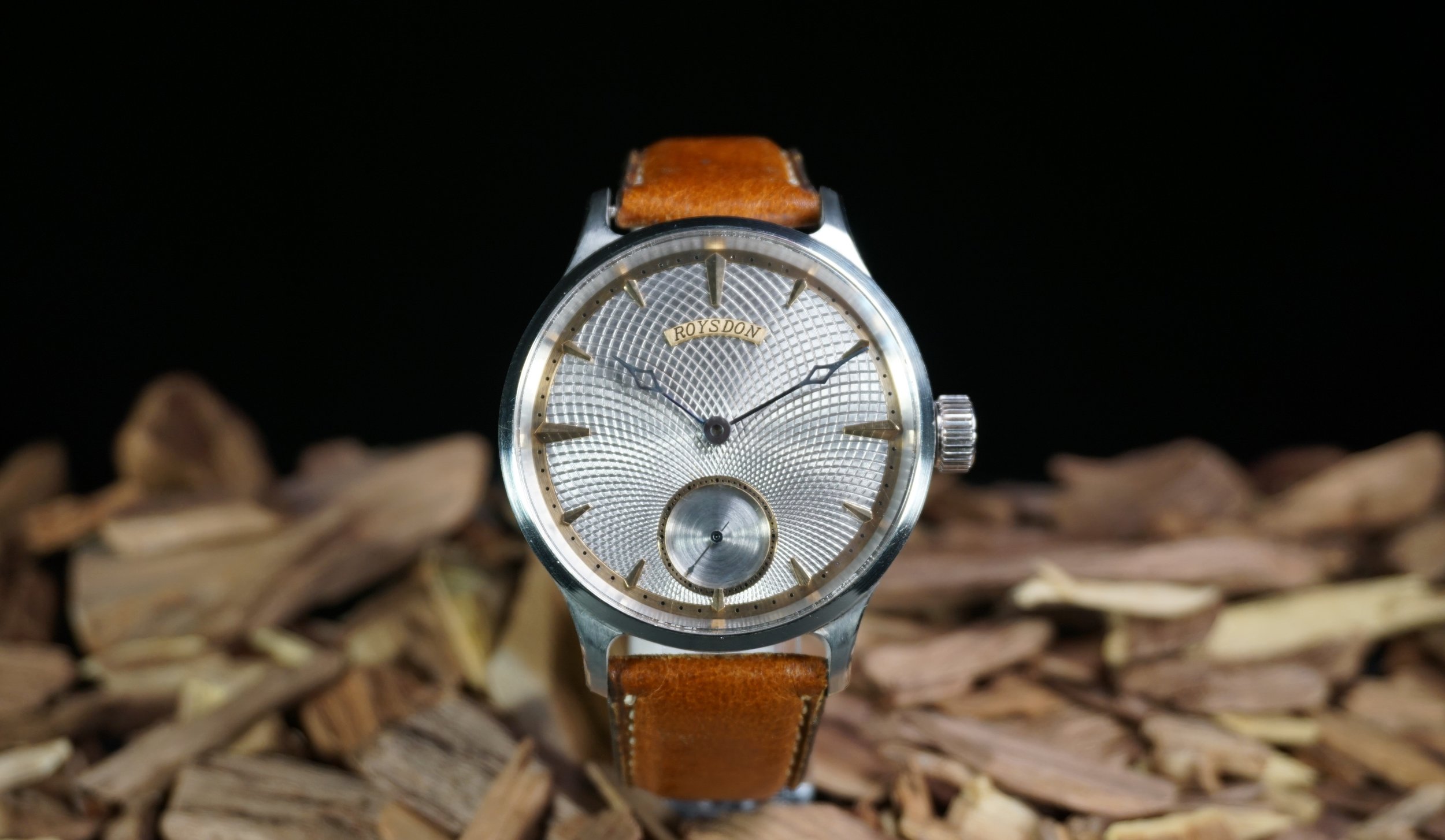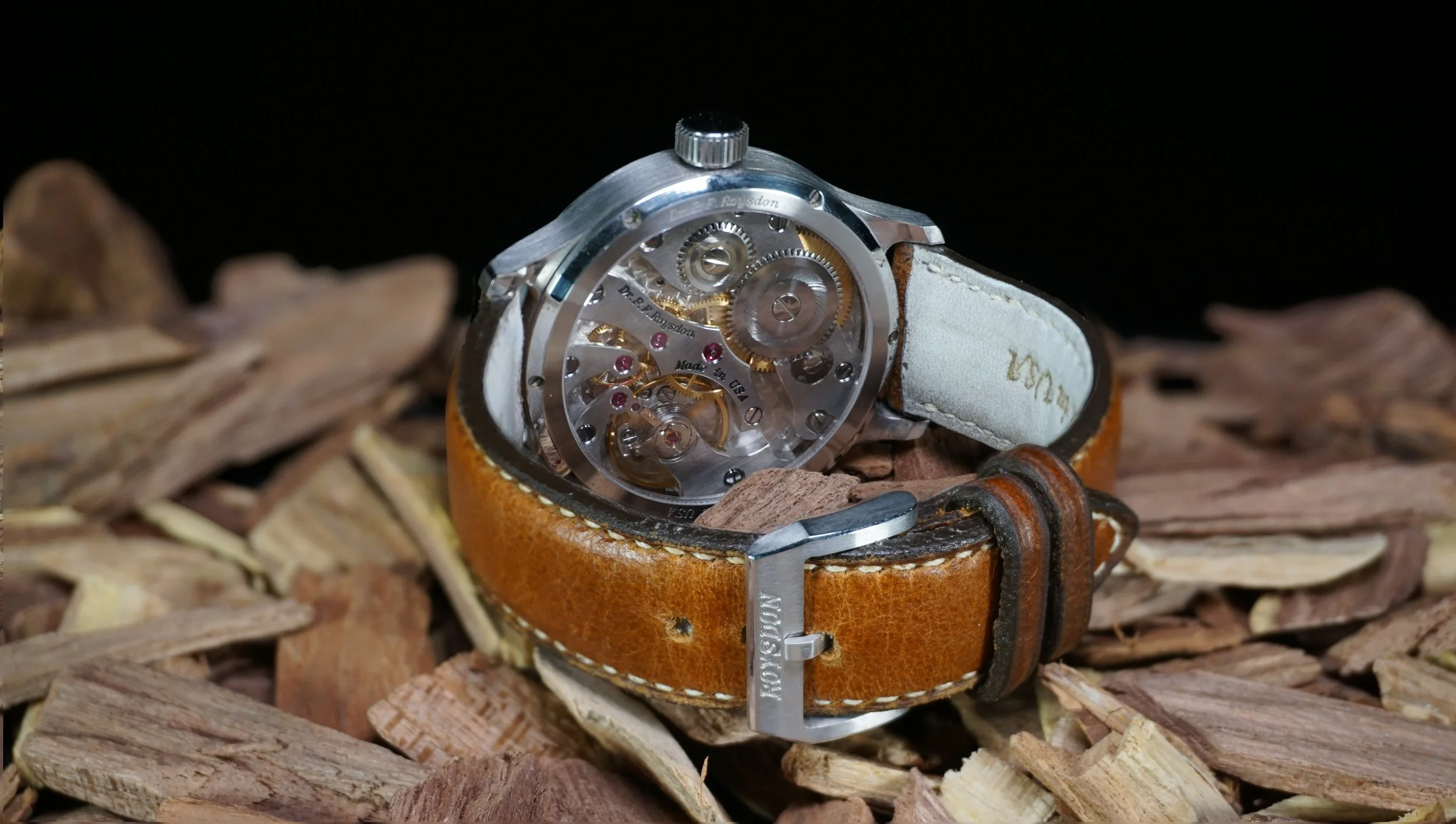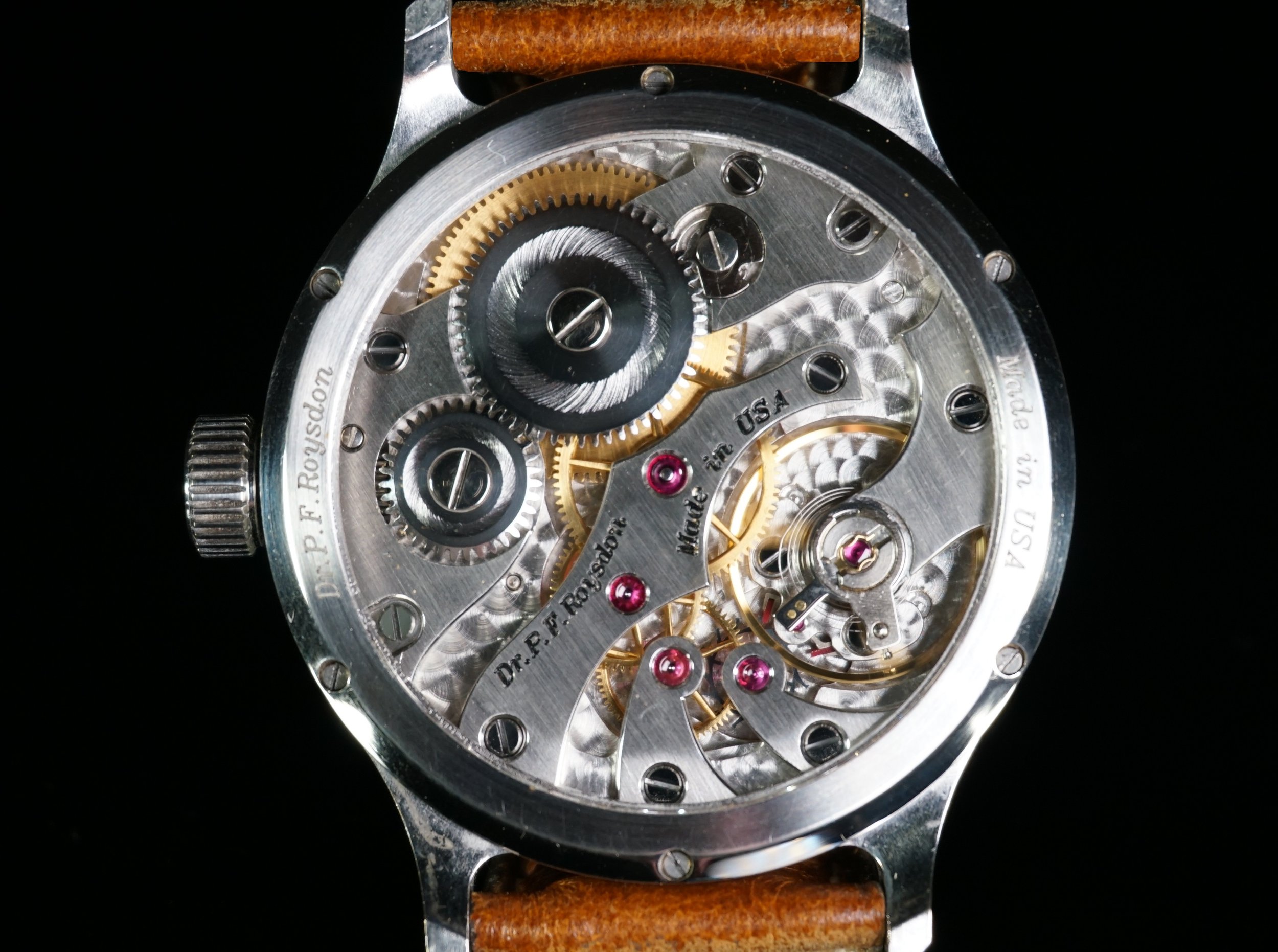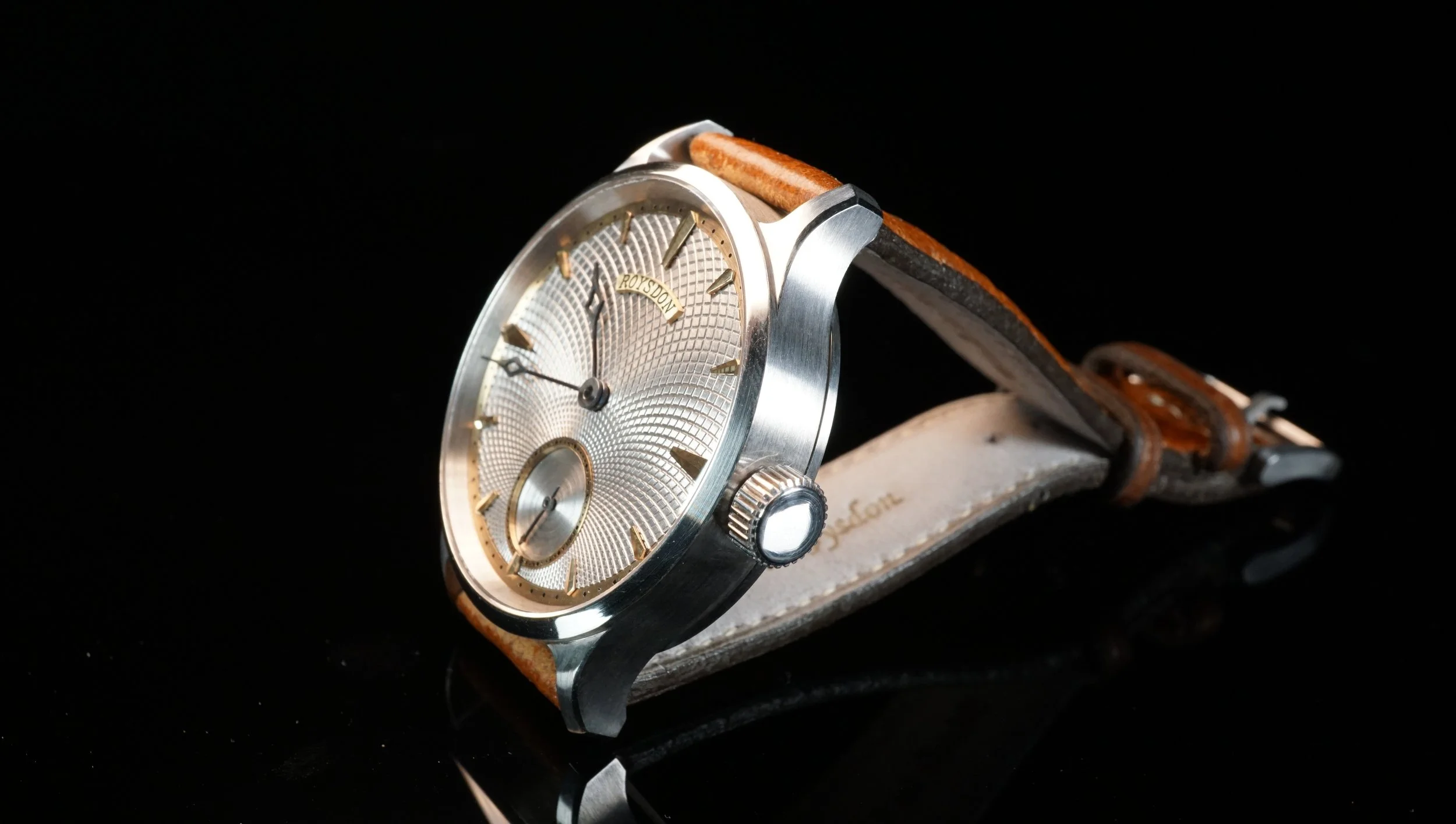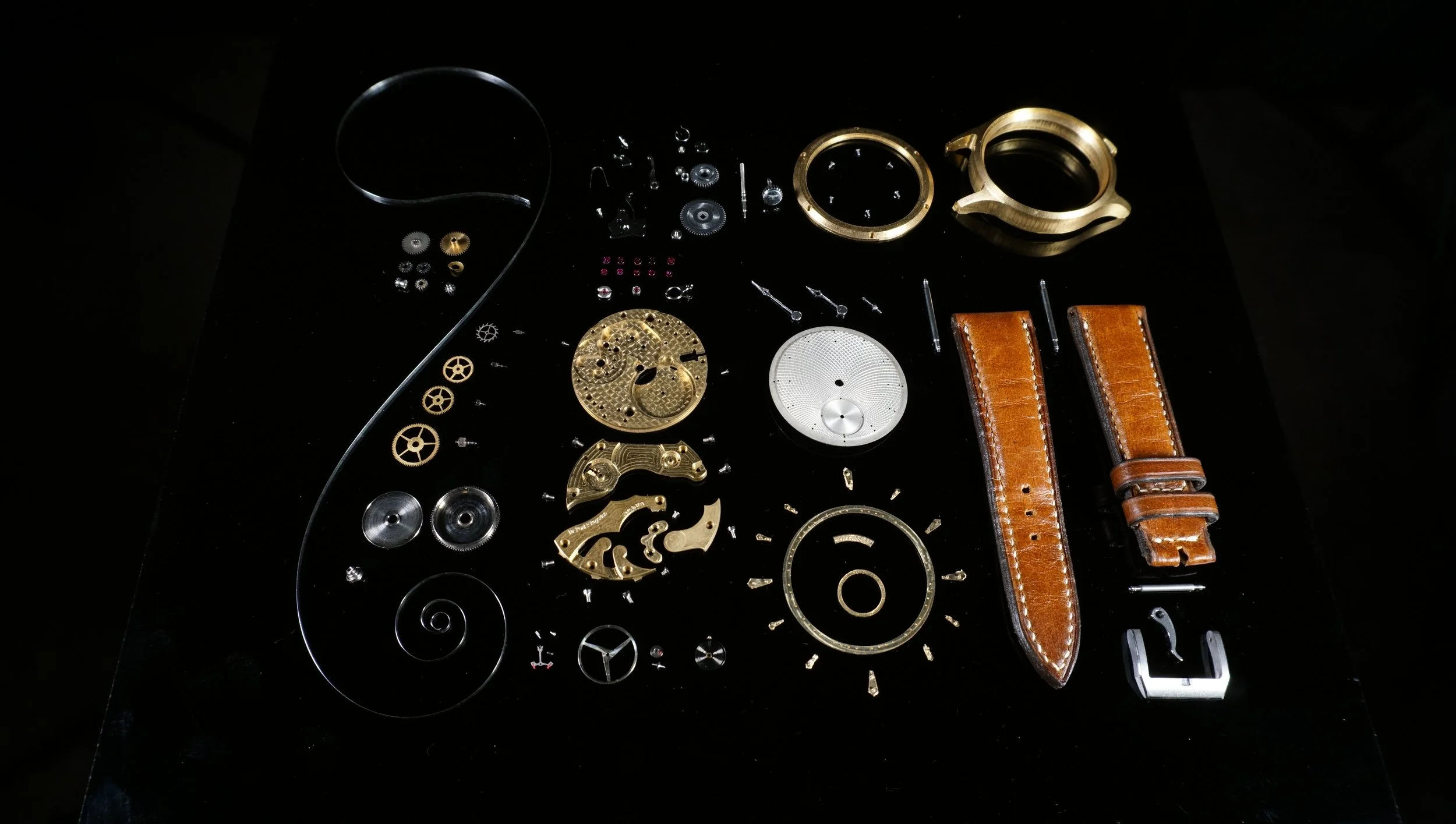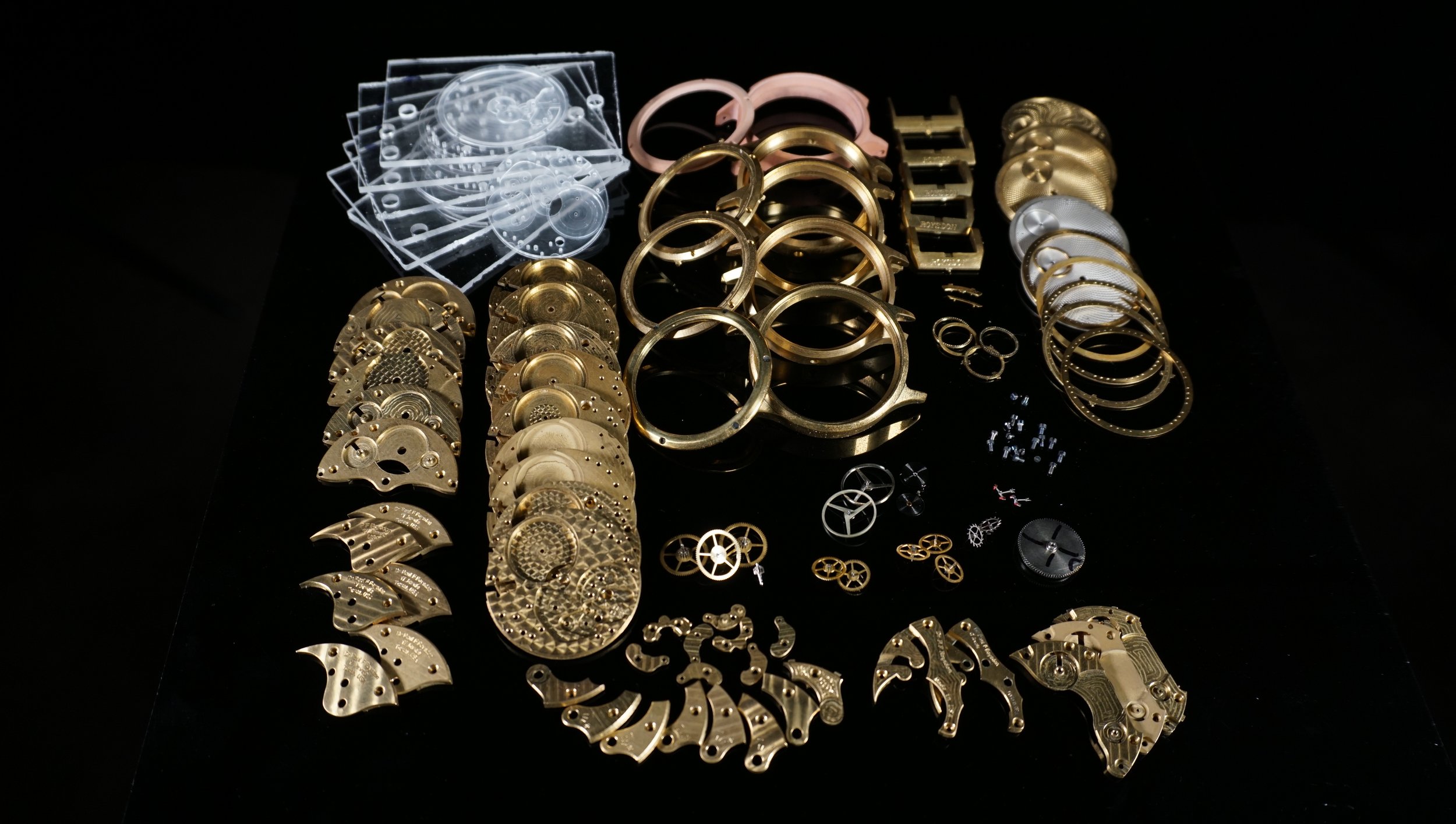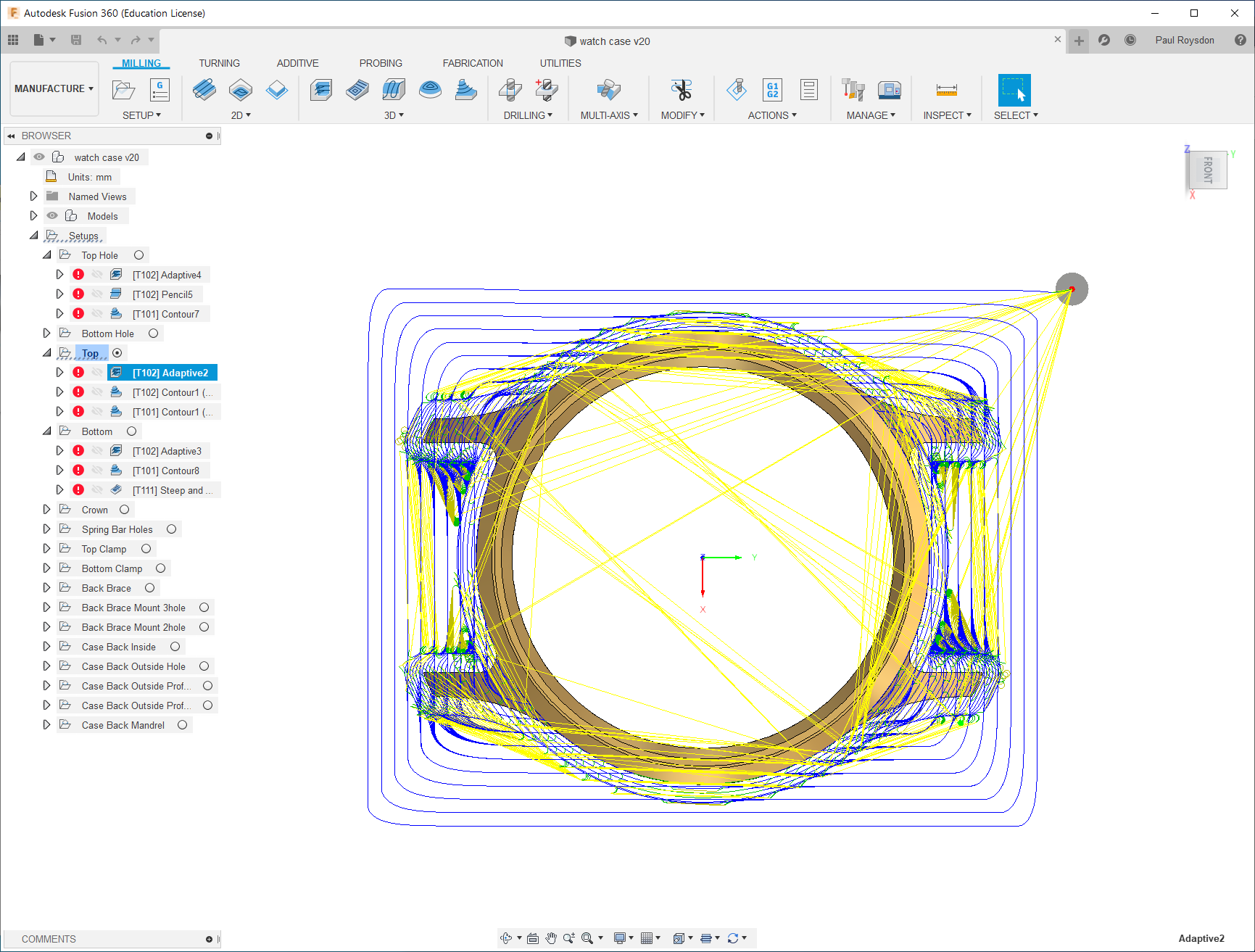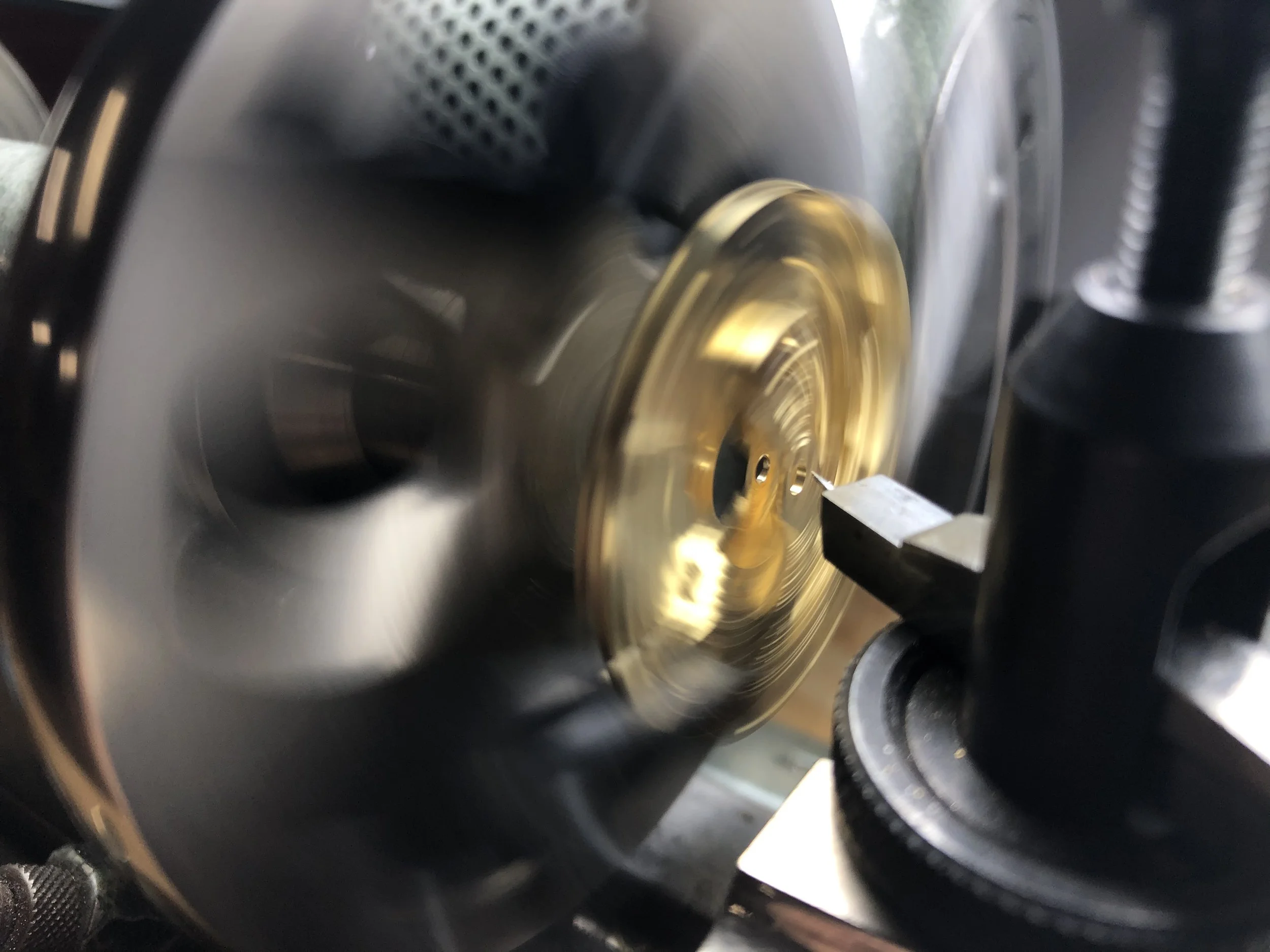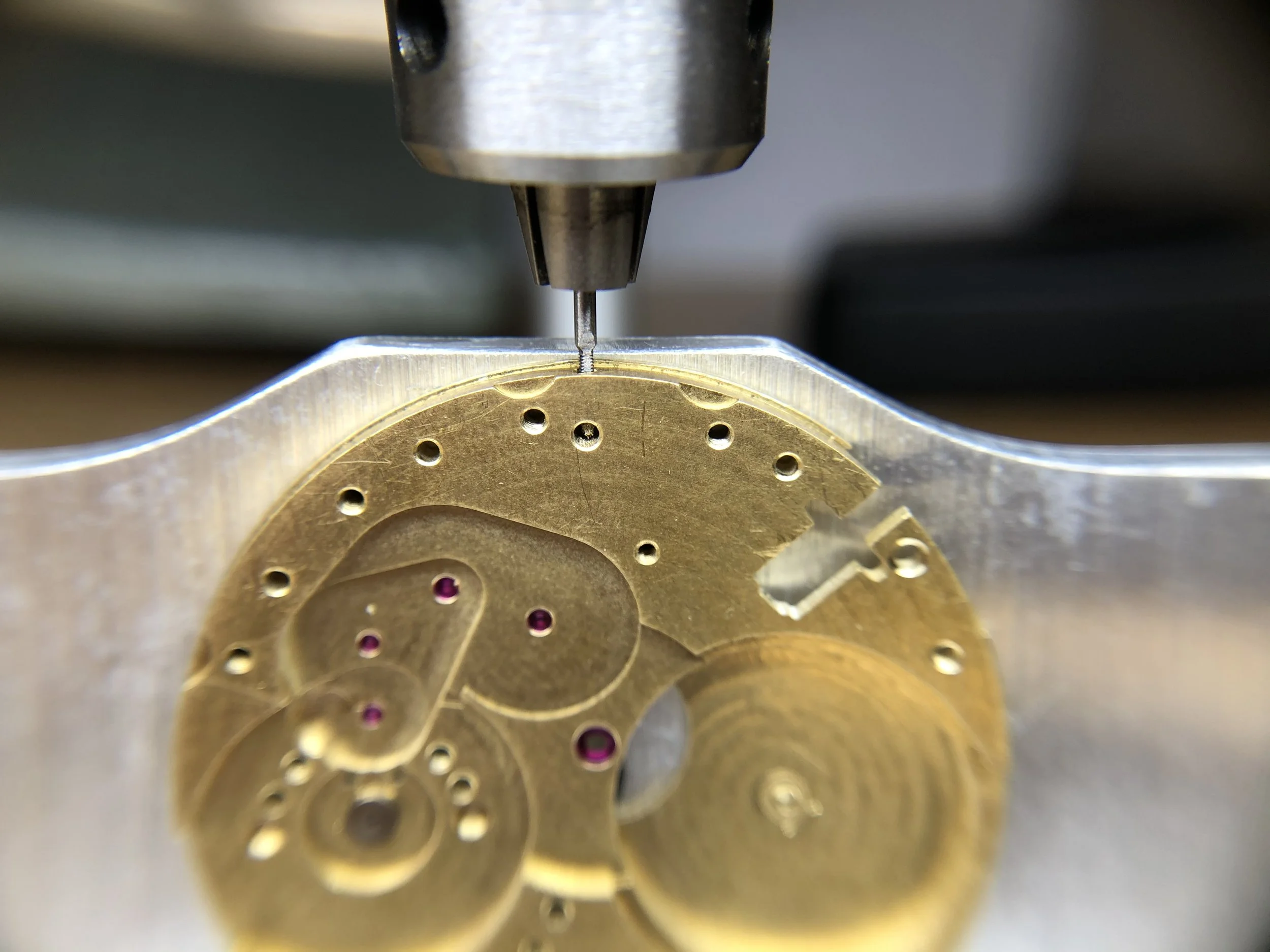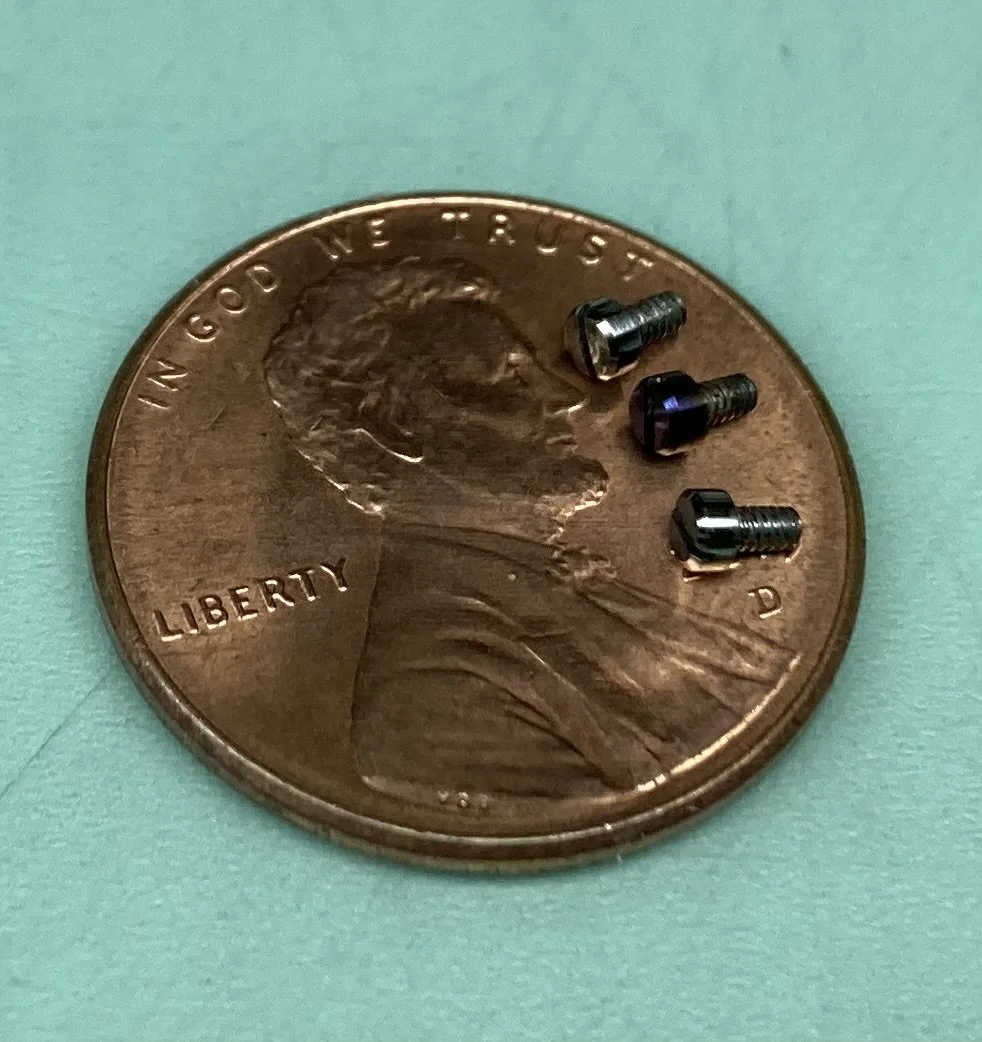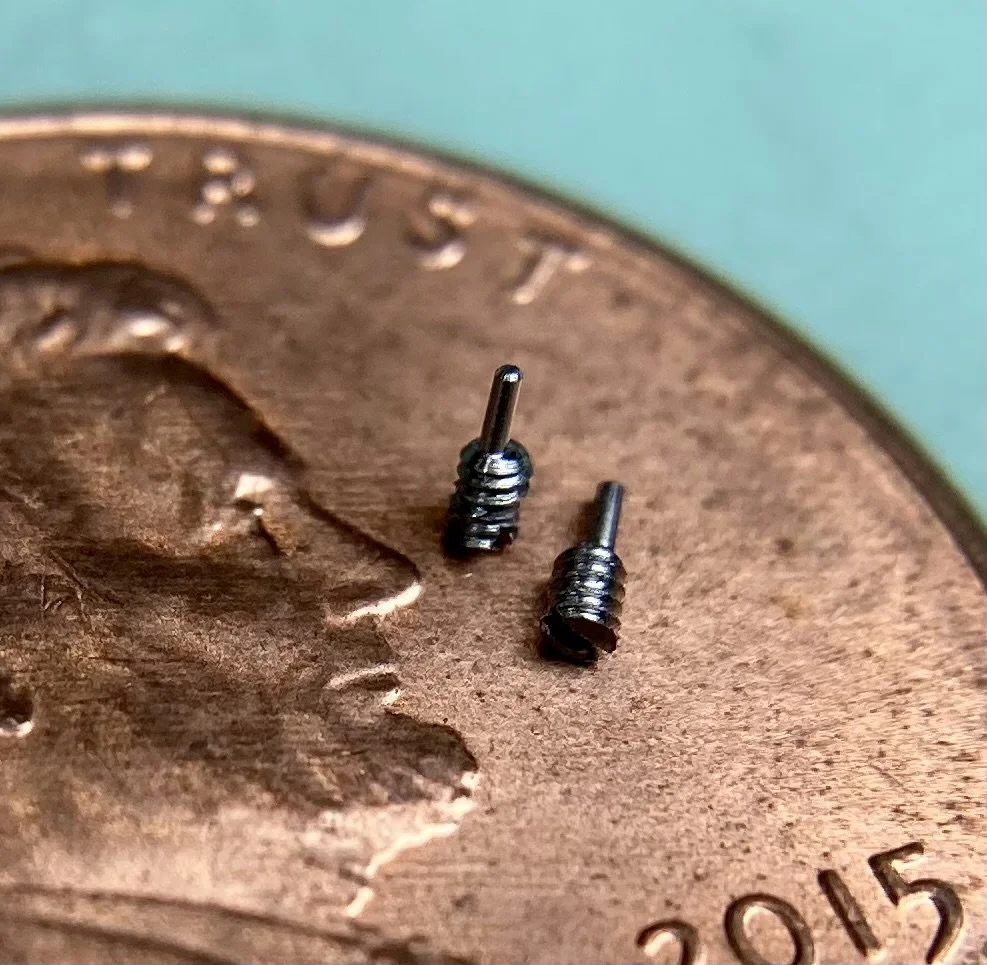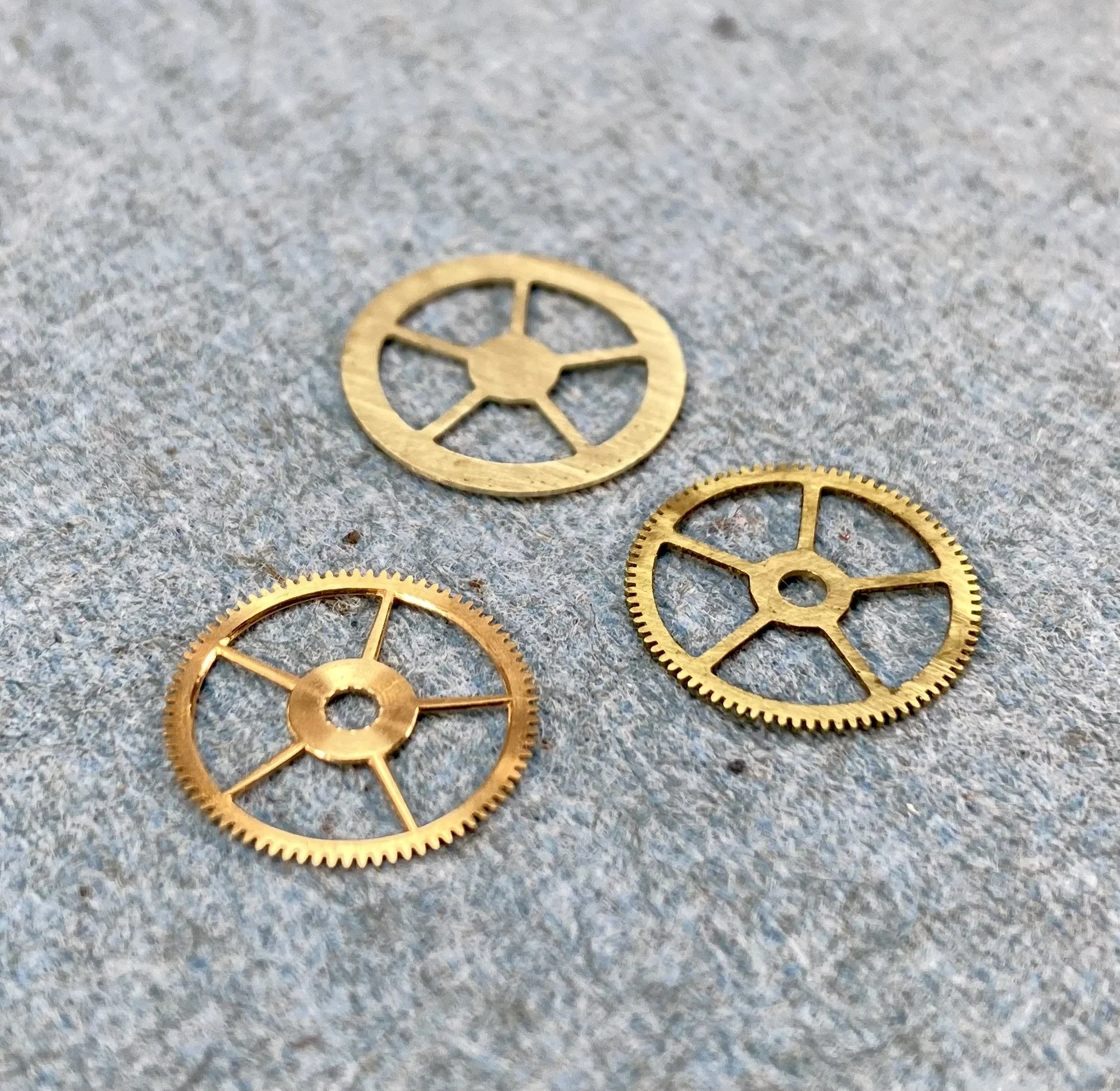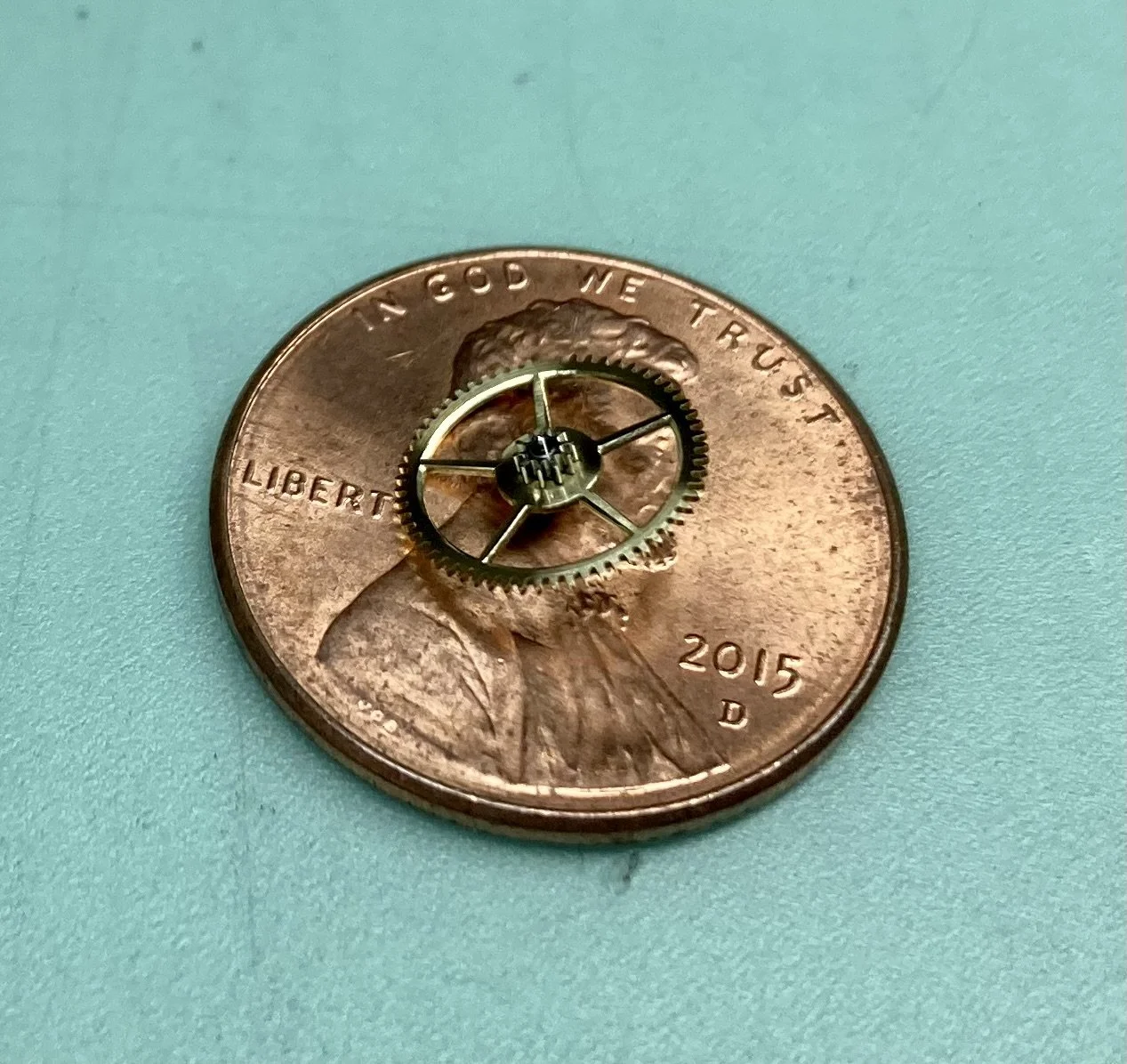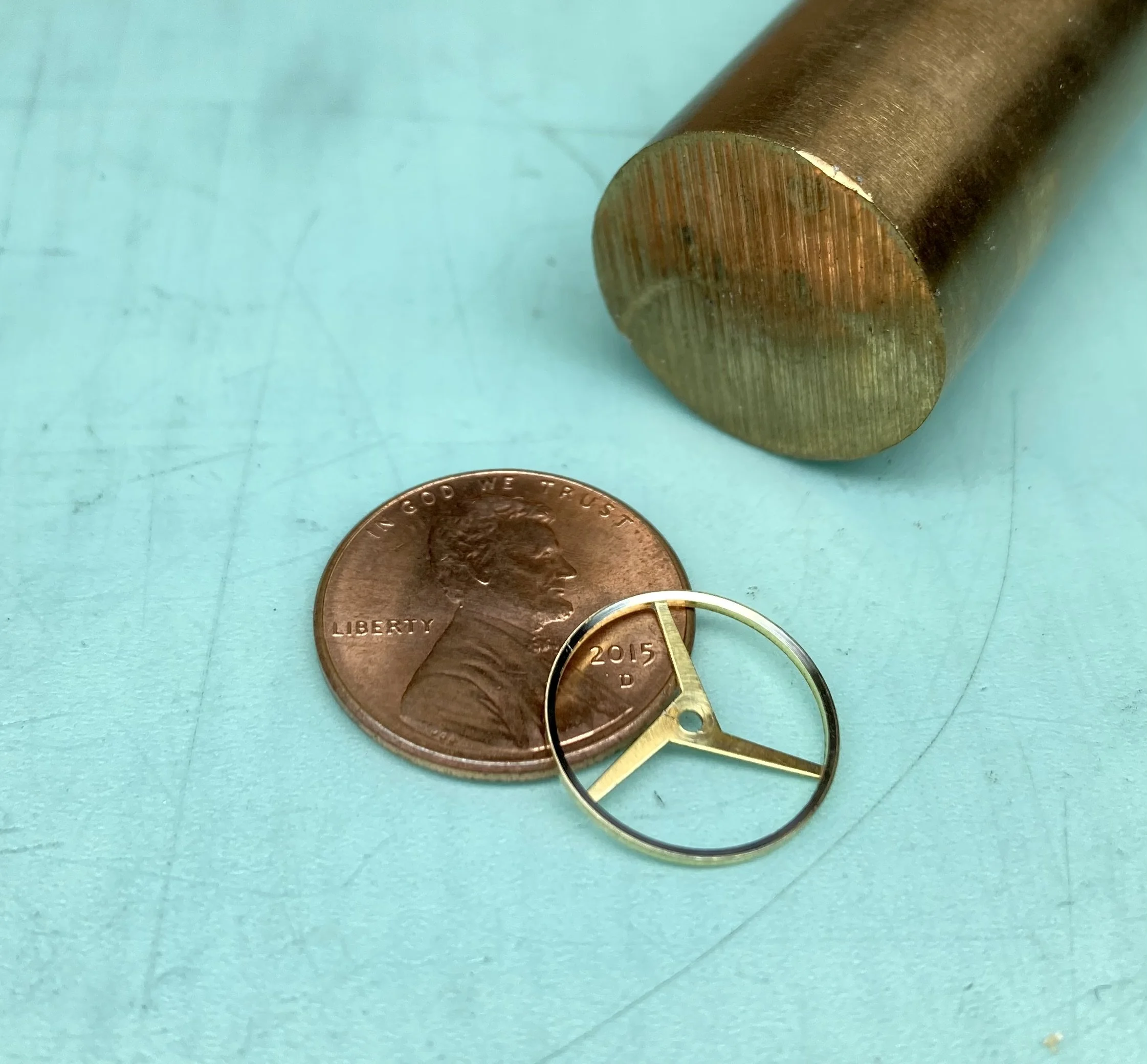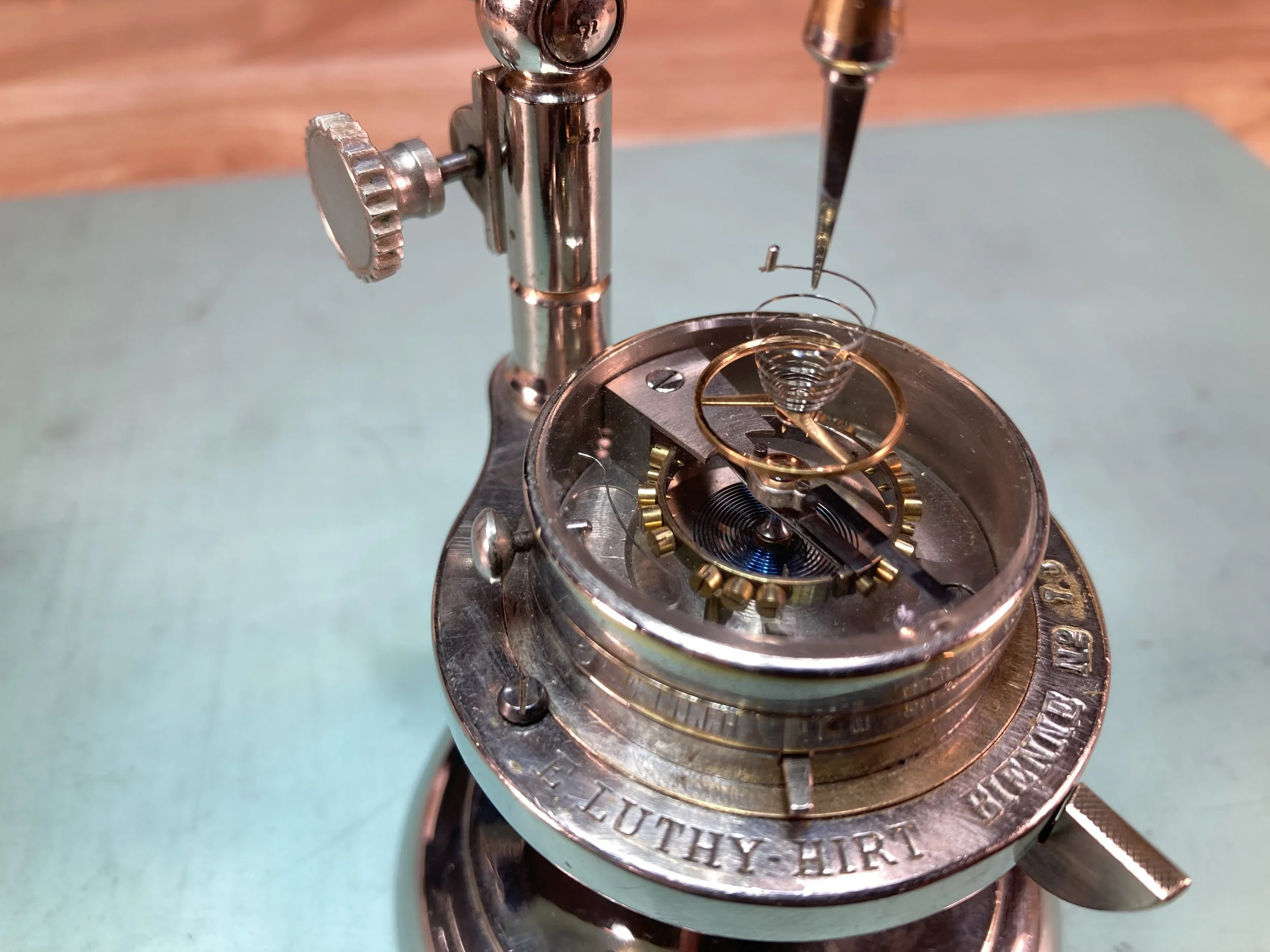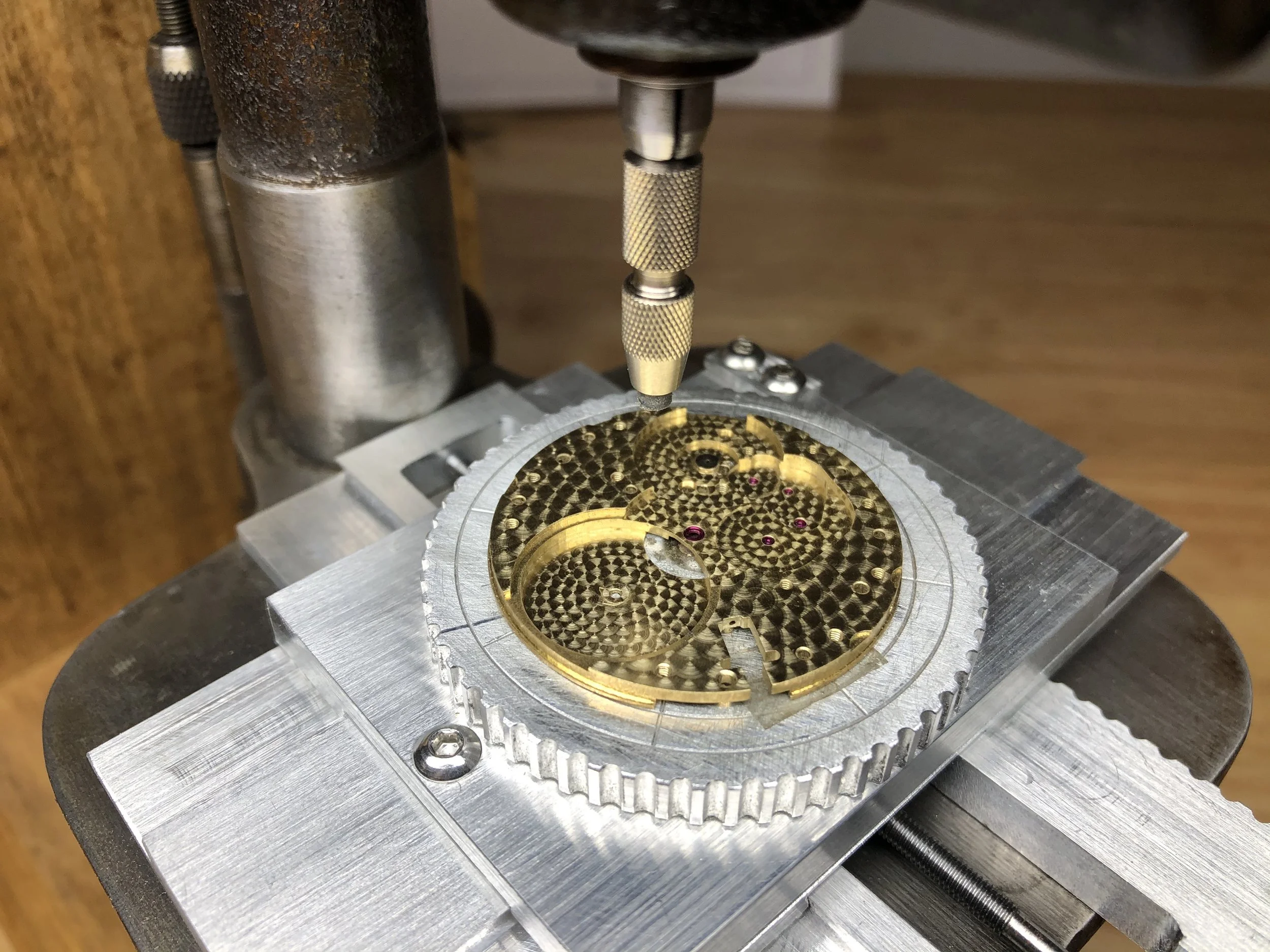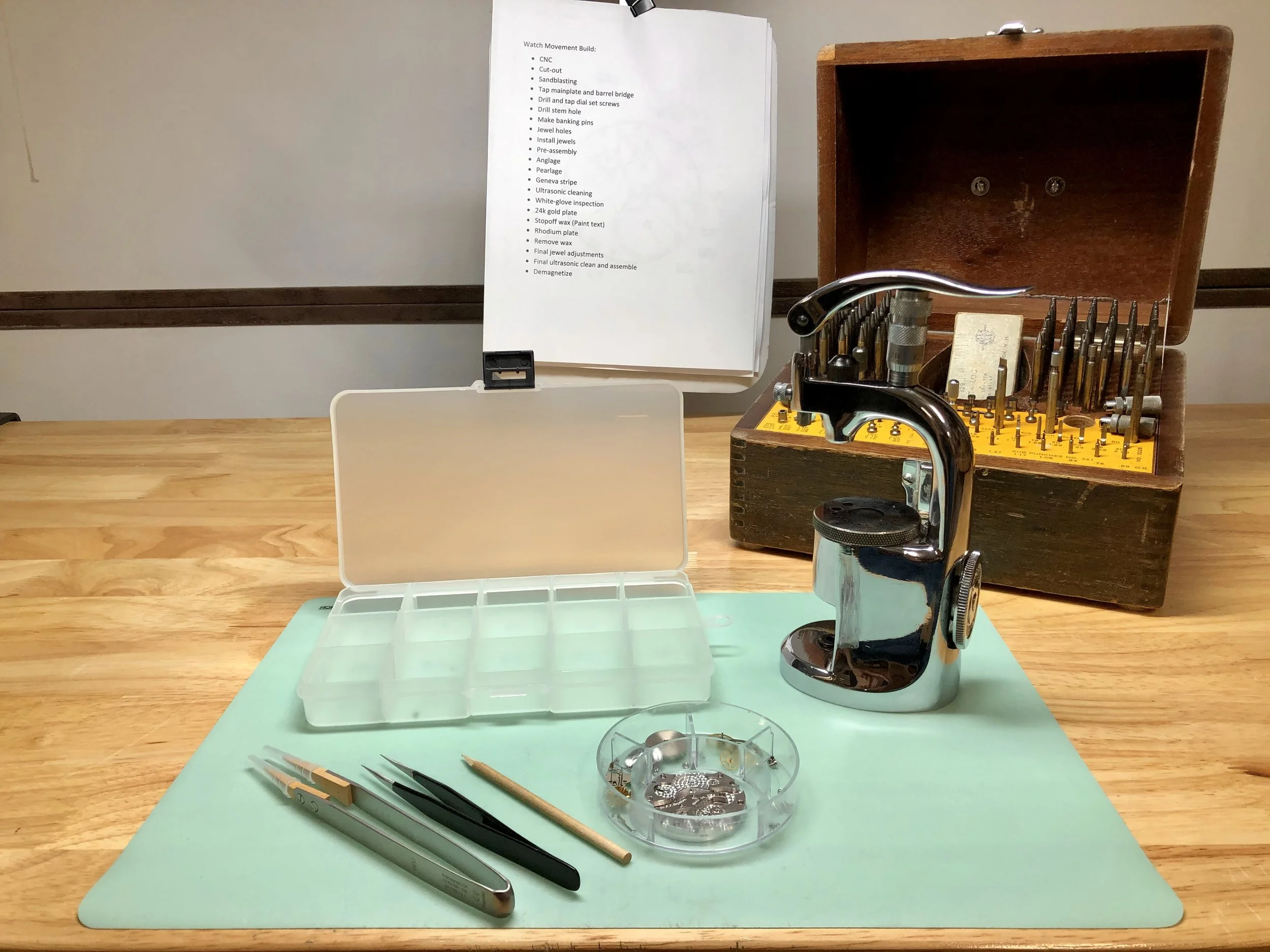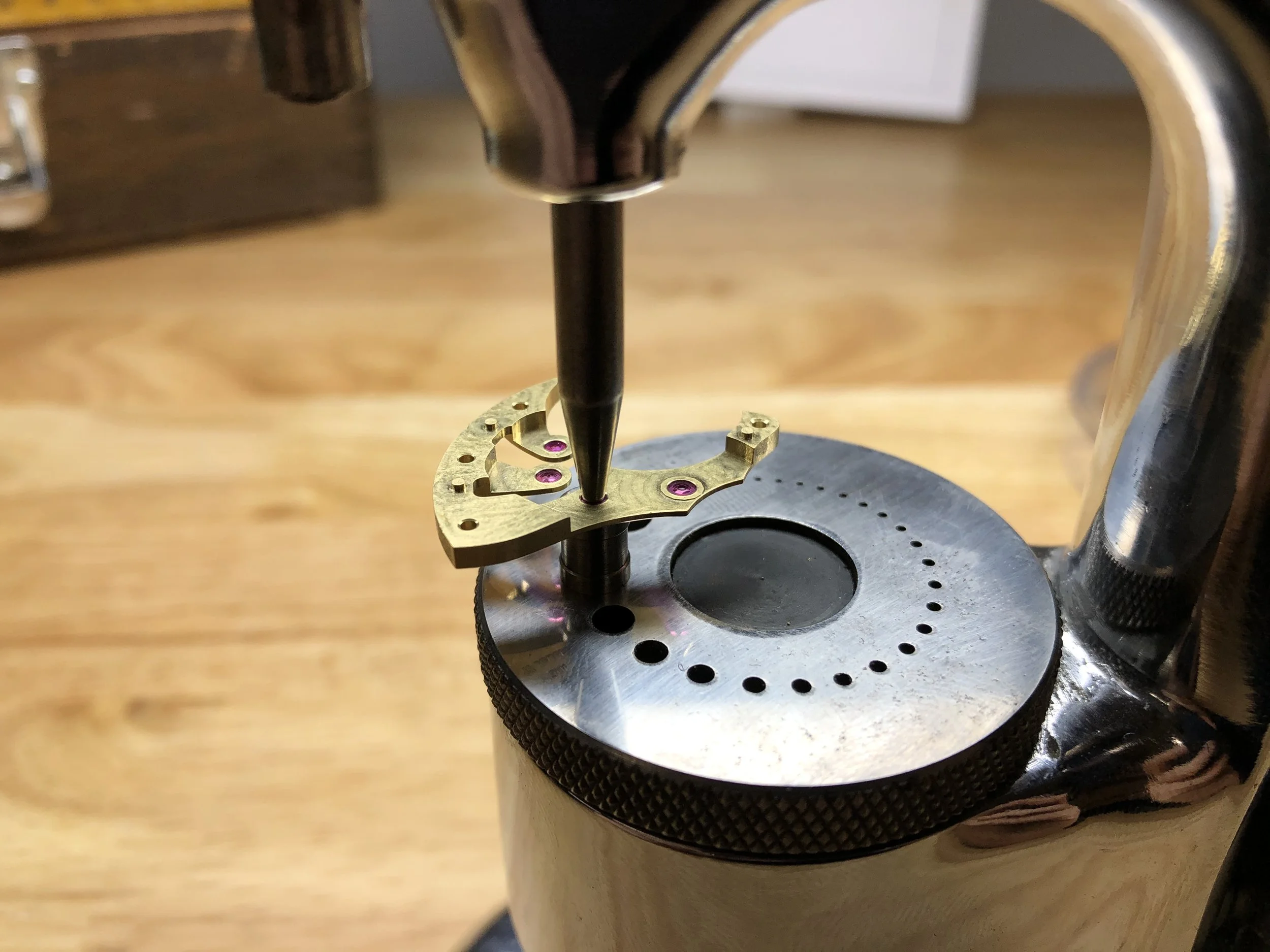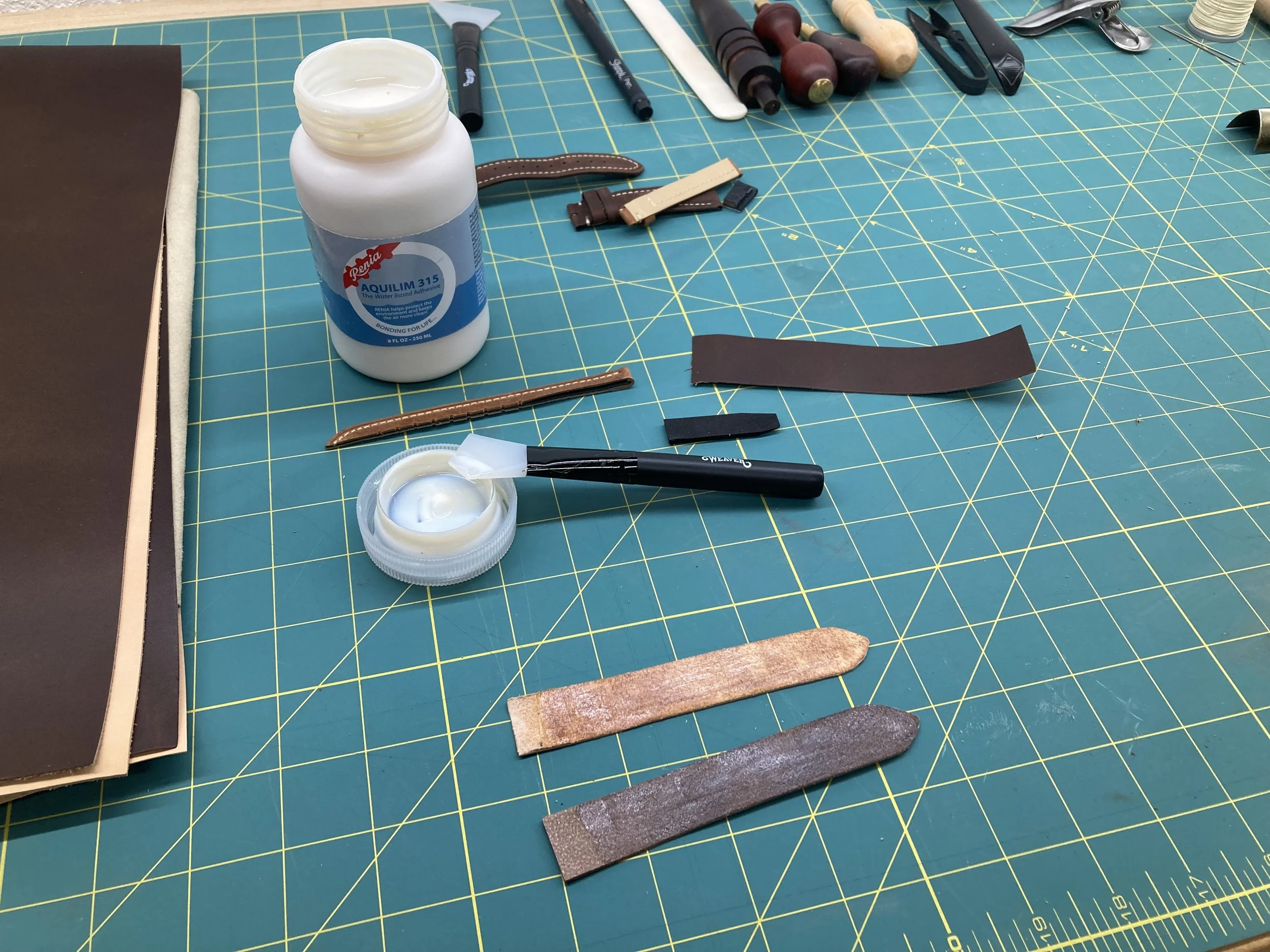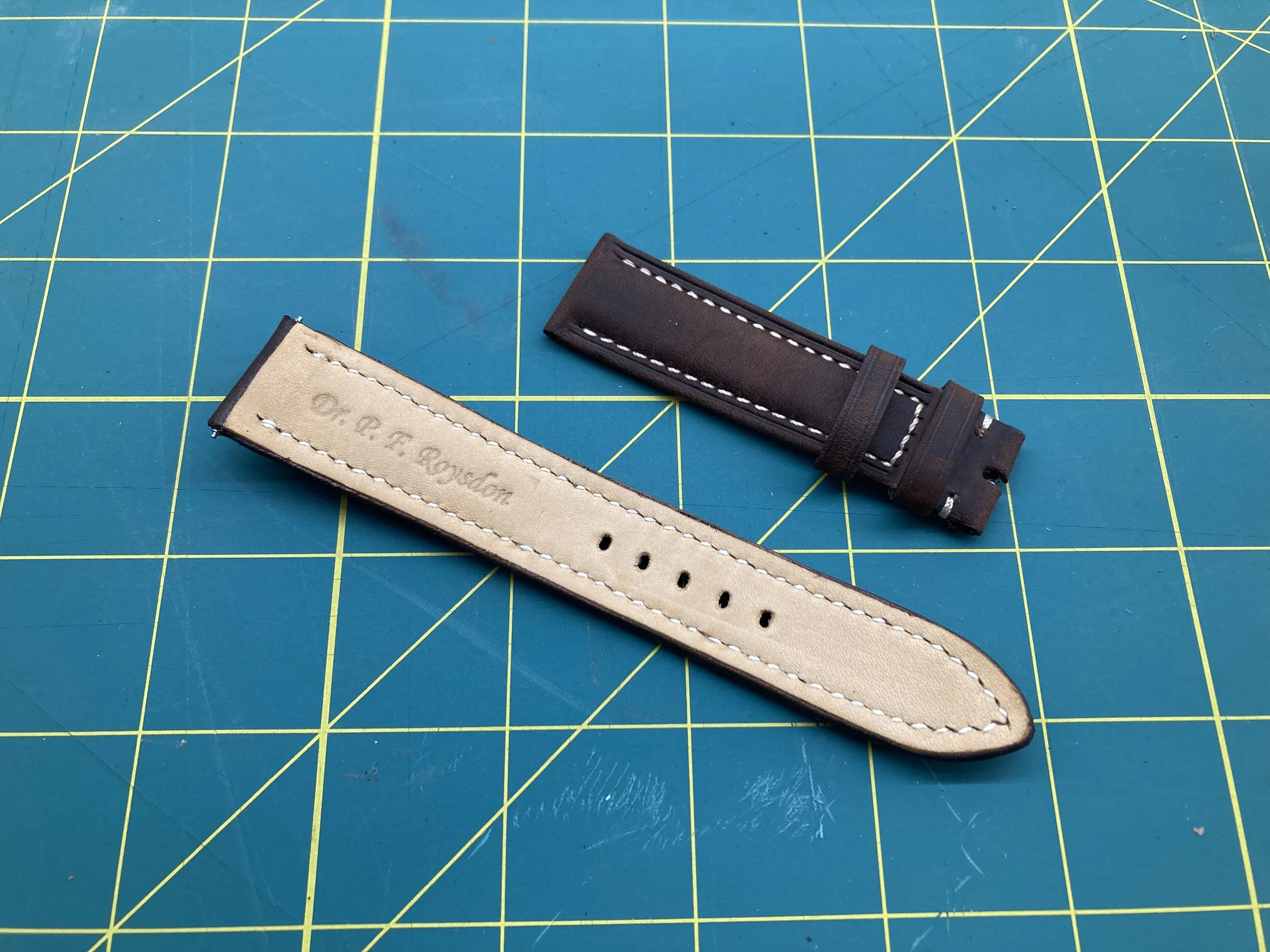Manufacturing Process of the Model One Prototype
Roysdon Model One - "Simply Time"
Welcome to the haute horlogerie of Texas independent watchmaker, Dr. P. F. Roysdon.
The Video
While some artists use oil paint on a canvas, Dr. Roysdon uses metals and mathematics to build hand-made watches in the style of haute horlogerie (“high-art of watchmaking”). The video captures 1,440 hours of work in six minutes, detailing the process from CAD design to manufacturing - from scratch, and nearly completely handmade using both traditional and modern watchmaking tools and methods. For his first watch, Dr. Roysdon chose the style of the Hamilton 945 because the parts are a bit larger than other watches, e.g. the ETA 2824, and they are often used in watchmaking schools. There are 122 hand-made pieces in the Model One. Only the jewels, hairspring, mainspring, and front and back sapphire crystals were purchased.
Essence of a Timepiece
The Roysdon Model One entices three senses:
The balance and hairspring are large enough that you can see the "heart beat" of the hairspring.
Next you can hear the beat as the jewels of the pallet fork strike the escape wheel.
Finally, because you cannot touch the wheels and pinions, the crown is cut with the same cutter used to cut the center wheel, enabling you to feel the profile of the teeth as you set or wind the watch.
These three senses make this watch a true experience that enable you to see, hear, and feel the components that make up the essence of a timepiece.
The Final Photos.
The final detail photos are the result of 1,440 hours of design and manufacturing.
Parts & Prototypes
There are exactly 122 components that are made for each Model One (top).
The journey to the first working and accurate Model One required no less than 20 prototypes, each of which were saved as evidence that nothing great ever happens the first time, instead a great product is refined over time with many iterations (bottom).
There are 122 hand-made pieces in the Model One. Only the jewels, hairspring, mainspring, and front and back sapphire crystals were purchased.
1,440 hours of work in just a few photos.
Below we describe the process of just some of the many steps and parts necessary to make a Model One. This is not a comprehensive list, and does not show photos of each step, rather it is an overview to give to some insight into level of effort necessary to build and entire watch from scratch in 1,440 hours.
CAD & CNC machining.
It all begins with an idea. The process to design a complete watch in CAD can take many months. After which several more months are spent determining the right materials to use, selecting the right endmills to cut the materials, determining the speeds and feeds for the CAM tool paths, and programming the tool paths for each stage, e.g., a single part like the mainplate requires 50 operations and 22 different tools. Then the CNC machining begins and prototypes are made. At this stage, most parts are scraps until the right combination of endmills, paths, etc., are determined, and only then is the final part made. This process is repeated for each and every part, e.g., case, dial, hands, movement mainplate and bridges. While modern tools and methods are employed, it is definitely not an automated process just because a CNC is used.
To the left is an example of the the CAD model and CAM tool paths for the exterior of the watch case, and below it a partially complete mainplate.
Hand Machining.
Several parts must be machined or completed by hand, e.g., jewel holes on the mainplate and bridges (top), drilling the spring-pin holes in the case, or tapping the 22 holes in the mainplate (bottom). This process is performed primarily on a watchmaker lathe and requires many weeks of work.
Making Screws.
Nearly everything on the Model One is made from scratch, including 14 screws. These tiny screws with a 0.5 mm to 1.2 mm thread diameter are made of steel on a watchmaker lathe, by hand, then hardened, tempered and black (mirror) polished. Unlike mass manufactured screws, both the head and the end of the screw are mirror polished, the slot must be media blasted to a satin finish, even the edges of the slot and perimeter of the screw head are chamfered with a straight-grain finish. Even small eccentric (off-center) banking pins must be made, wherein the 0.3 mm pin is off center by 0.15 mm and the thread is 0.5 mm (bottom). Making a single screw takes 8 hours.
Making Wheels & Pinions.
The most difficult step in watchmaking is making wheels and pinions. Great skill and attention to detail is necessary to ensure that the diameter is correct and the teeth are well formed and polished (to minimize friction). Wheels are milled on the lathe using a mandrel, 6 wheels at a time. Each wheel starts as a blank machined on the CNC mill (top), then the teeth are cut on a lathe (middle), then the spokes and rim are chamfered, mirror polished and the top surface is straight-grained, finally the pinion is “staked” to the wheel, and the teeth are polished (right). Each wheel and pinion can take several days to make.
Making the Balance & Hairspring.
The balance is tricky and needs to be… well… balanced. After machining the balance (top) from beryllium copper — a thermally stable material used to prevent time fluctuation due to temperature changes — the balance is trued and adjusted on a variety of tools, including a set of ruby jaws to detect the slightest mass imbalance in the rim of the balance; a perfect balance will not have a heavy point that cases the balance to roll until the heavy part is at the bottom due to the influence of gravity (middle). Then the hairspring is cut and formed on another precision tool that assists in the adjustment, and then it oscillated to match a master balance at exactly 18,000 bph (bottom).
Polishing & Finishing.
The adage, the last 10% accounts for 90% of the time spent… well this is certainly true in watchmaking, specifically polishing and finishing. For example, it takes only a few hours to machine the train-wheel bridge and bore the jewel holes, but this same bridge (shown on the bottom) takes 40 hours to finish and polish. First the “pearlage” finishing is performed on a dedicated sensitive precision drill press (top), then the edges are chamferred and mirror polished (bottom), and finally the parts are electroplated with 24k gold and rhodium.
Jeweling
Each ruby jewel is press-fit using very precise tools and tolerances, such that the gap between the jewel and the pinion results in 0.05 mm of “end shake” or up/down movement of the wheel and pinion. During the boring operation described above, the hole is bored 0.01 mm smaller in diameter to ensure a snug press-fit of the jewel. This step takes many hours for each bridge and the mainplate.
Making a Leather Watch Band
Each band is made from Texas-sourced premium leather outer layer and soft nubuck leather lining. The process requires 48 steps: from cutting the leather parts and bonding the layers (top), to hand stitching (middle), and finally finishing and branding (bottom). Each band takes roughly 8 hours to make.
Background
Materials
Unfortunately, the watchmaking industry is traditionally very secretive about the materials and processes of watchmaking. Most watchmaking materials cannot be purchased in America, and the materials referenced in vintage books are obsolete. Therefore, Dr. Roysdon applied his skills in research and experimentation to find equivalent materials that could be sourced in America. He performed a careful analysis of the material properties of Swiss metallurgy, e.g. alloys, hardness, elongation, etc. and ordered similar materials. He then experimented with dozens of materials on a CNC mill and a watchmakers lathe, analyzing not only the machineability but also the ability to bring the material to a mirror polish (black polish). Many materials were difficult machine, harden and temper, or turned grey (instead of pure black) when polished. After many years, he now has a list of locally sourced materials for his watches.
Technique & Practice
Unlike many independent watchmakers, Dr. Roysdon did not learn watchmaking by attending a watchmaking school. Instead he read books, studied macro photos and videos of movements by other independent watchmakers, and practiced by restoring hundreds of vintage watches and pocket-watches. In recent years, thanks to social media, there is an abundance of photos available not only of a variety of movements, but also of the process and tools. These social-media photos rapidly improved his knowledge-base while he practiced at the bench for hundreds of hours to perfect these skills. For example:
Dr. Roysdon spent a month making - by hand - the same screw 35 times, to perfect both the manufacture process (shaping, thread forming, slotting, chamferring) as well as the finish process (satin finish of the slot, straight grain the perimeter, and mirror polishing the head). A similar “study” was performed on all major components of his timepiece. While, “practice makes perfect”, practice also reduces the time to complete tasks. A single screw now requires only two hours (start to finish) instead of ten hours.
Other operations still take time and patience, e.g. 40 hours are required to chamfer and mirror polish the edges of the train bridge - yes 40 hours for just the edges - this is shown in the video (time 1:52) and photos below.
While the Model One is his first, from-scratch movement, it is not the first movement Dr. Roysdon produced. He made 20 complete movements from scratch (see the photos below) before he felt that the level of fit and finish was acceptable for public display.
Though some parts are"roughed-out" on a 4-axis CNC mill, many parts are entirely hand-made, e.g., wheels, pinions, screws, strap, even the spring-bars in the strap.
Tools
The process of watchmaking requires mastery of 46 trades, as well as the tools of those trades, e.g. metallurgy and blacksmithing, leather-craft, machining, etc. While American watchmaking was the best in the world in the early to mid-1900’s, all of those companies and trade schools have long since closed, replaced by Swiss companies and schools. Therefore, it is very difficult to build and equip an American watchmaking workshop. It took several years to acquire (purchase) the tools prior to starting the Model One. In some cases the tools are prohibitively expensive, e.g. a high precision CNC mill can cost over $500,000, so traditional hand-made and laborious methods were employed. Similarly, some tools are exceptionally rare, e.g. Guilloche tools (Rose or Straight-line engine), and therefore a facsimile was created using Dr. Roysdon’s skill in mathematics and programming as well as a CNC mill. While his Guilloche method is innovative - using modern software and tools to replicate traditional methods - Dr. Roysdon now uses traditional (vintage) Rose and Straight-line engines his workshop.
The Roysdon Model One and all associated jigs and fixtures were designed using Fusion360 for CAD design and CAM tool-paths. The CNC work is now performed on a NS-CNC Elara 4-axis mill, while all other operations were performed using a variety of manual machines and tools, e.g. a 1940's Boley F1 lathe, and various tools from Levin, Bergeon, Leica, K&D, etc. To build and assemble this timepiece, it took several years to purchase nearly 3,000 tools, and manufacture — from scratch — over 50 unique jigs and fixtures specific to this movement.
Model One Details
Case, Dial & Movement
The case and crown are made in a brilliant platinum (Rhodium), for long wear and scratch protection. The case is water resistant to 10 meters. The front features a double-domed sapphire crystal to resist scratches and accentuate the beauty of the dial, while the case back uses a flat sapphire crystal to display the beautiful movement.
The dial is also made in platinum with 18k gold hour indices and chapter rings. The hands are hand-made from high carbon steel, heat treated to a deep blue, and mirror polished tip and boss.
The movement is made in platinum, with high carbon steel pinions, 24k gold wheels, and ruby jewels. In the tradition of high horology, each hand-made screw features a chamferred and polished slot, and mirror polished screw head. All steel parts in the watch are mirror polished, the most visible component (aside from the screws) is the escape wheel.
Leather Strap
Texas leather, tough as a cowboy and the king of patina, picks up marks and scratches that blend gracefully and improve the appearance with time.
Every strap is saddle stitched by hand as shown in the video. Unlike lock stitch created by machines, a saddle stitch is more durable as it is made of two independent stitches that form a knot at every stitch. Linen thread in 0.35mm thickness was selected for a fine and natural weave.
The edges are finished with multiple layers of edge paint to seal the raw edges. To achieve the desired finish, the edges are repeatedly sanded and edge paint is applied.
The strap is lined with silky smooth Nubuck leather, specially developed for use as a lining material. It is soft to the touch and comfortable even after hours of wear. The leather is water- and sweat-resistant and works well even in hot and humid climate.
The straps comes fitted with a brilliant platinum (Rhodium) hand made buckle, straight grained surfaces with mirror polished chamfers, engraved with our family name. It brings about a sophisticated yet durable look to the strap. Even spring bars are hand made on the Boley F1 lathe!

